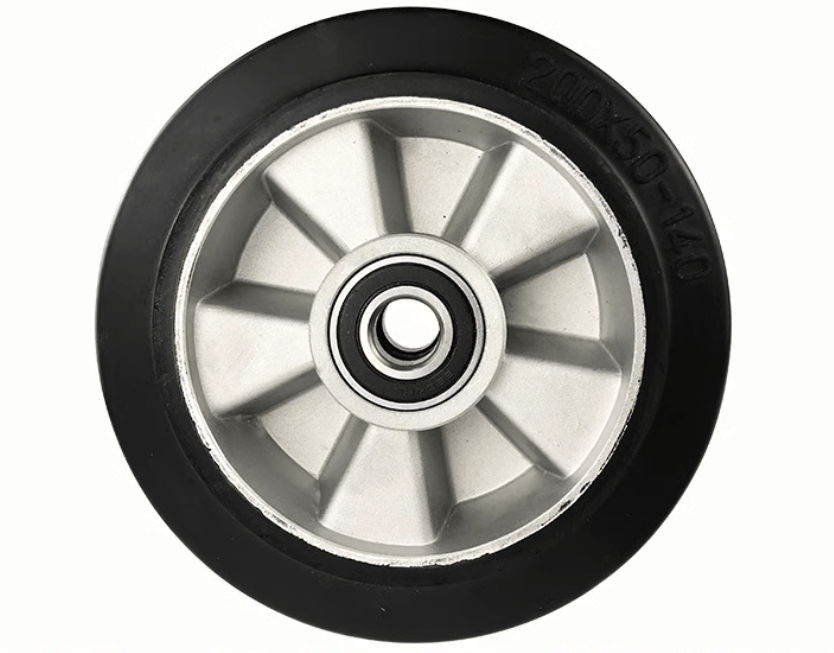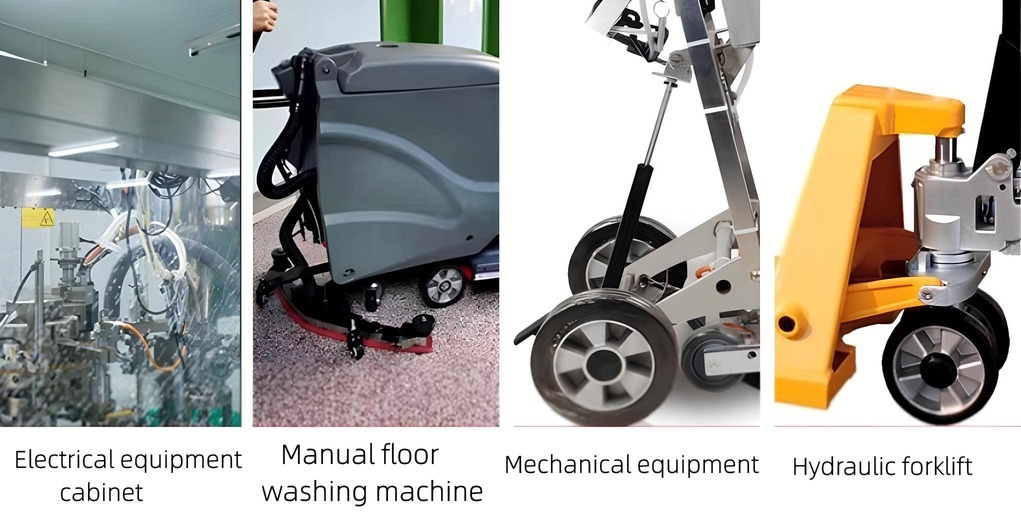Rubber wheels are an essential component in various industries, but have you ever wondered what makes them so popular and versatile?
Rubber wheels are used for a wide range of applications. They provide excellent shock absorption, durability, and traction, making them ideal for heavy-duty tasks, smooth operation, and various types of equipment.

In this article, we’ll dive deeper into what rubber wheels are used for, how they perform in different settings, and what makes them the preferred choice in many industries. Let’s explore the technical details of these essential components.
What are Rubber Wheels?
Rubber wheels are one of the most widely used types of wheels. But what exactly are they made from, and why do they have such widespread application?
Rubber wheels are made from natural or synthetic rubber, often reinforced with other materials. They provide a smooth ride, excellent durability, and the ability to absorb shock and reduce noise.
Material Composition of Rubber Wheels
Rubber wheels are primarily composed of natural or synthetic rubber compounds, which are chosen based on the specific performance characteristics required for the application. The two main types of rubber used in wheels are:
Natural Rubber: Known for its elasticity and resilience, it offers high shock absorption and is commonly used in applications that require low rolling resistance.
Synthetic Rubber: This includes varieties such as SBR (Styrene Butadiene Rubber) and EPDM (Ethylene Propylene Diene Monomer). These types are more resistant to weathering, oils, and chemicals, making them suitable for industrial and outdoor applications.
Performance Factors
Rubber wheels are known for their ability to absorb vibrations, reduce noise, and offer a smooth ride even on rough surfaces. They are especially effective in environments where metal or plastic wheels would cause excessive wear on the surface or equipment. The following table compares the main performance attributes of rubber wheels and other types:
| Performance Attribute | Rubber Wheels | Polyurethane Wheels | Steel Wheels |
|---|---|---|---|
| Shock Absorption | High | Medium | Low |
| Durability | Medium | High | Very High |
| Noise Reduction | Excellent | Good | Poor |
| Traction | Excellent | Good | Excellent |
| Cost | Moderate | High | Low |
Applications of Rubber Wheels
1. Industrial and Manufacturing Environments
- Warehouse and Distribution Centers: Ideal for moving heavy loads efficiently across large areas, enhancing productivity in logistics operations.
- Manufacturing Plants: Used for transporting materials, components, and finished goods within manufacturing environments.
2. Retail and Consumer Environments
- Retail Environments: Facilitate the movement of merchandise and restocking of shelves with minimal disruption to customers.
- Shopping Carts and Baggage Trolleys: Commonly used for ergonomic mobility in shopping carts and airport baggage trolleys.
3. Healthcare and Medical Facilities
- Healthcare Facilities: Suitable for transporting medical equipment and supplies due to their quiet operation.
4. Office and Educational Settings
- Office Environments: Commonly found on office furniture, enabling easy movement without damaging floors.
- Libraries and Educational Institutions: Non-marking nature makes them ideal for libraries, ensuring floors remain undamaged.
5. Laboratories and Food Service
- Laboratories and Industrial Kitchens: Resistant to chemicals and moisture, making them suitable for laboratory settings and industrial kitchens.
6. Construction Sites
- Construction Equipment: Durable performance in rugged environments, popular for construction equipment and tools.
7. Other Applications
- Medical Devices: Support the quiet movement of medical equipment.
- Industrial Equipment: Ensure smooth mobility for machinery and heavy-duty carts in warehouses.
Comparison Table: Applications of Rubber Wheels
| Environment | Key Application | Primary Benefit | Typical Use Case |
|---|---|---|---|
| Warehouse & Distribution | Moving heavy loads efficiently | Durability & Traction | Pallet jacks, logistics carts |
| Manufacturing Plants | Transporting materials & goods | Shock Absorption | Assembly line carts, tool transport |
| Retail Environments | Restocking shelves with minimal disruption | Floor Protection | Stock carts, display movers |
| Shopping Carts & Trolleys | Ergonomic mobility for consumers | Durability & Traction | Grocery carts, airport baggage trolleys |
| Healthcare Facilities | Moving medical equipment quietly | Shock Absorption | Hospital beds, supply carts |
| Office Environments | Easy furniture movement | Floor Protection | Office chairs, rolling cabinets |
| Libraries & Education | Non-marking movement | Floor Protection | Book carts, classroom furniture |
| Labs & Industrial Kitchens | Chemical/moisture-resistant transport | Durability & Traction | Lab carts, food prep trolleys |
| Construction Sites | Durable performance in rugged areas | Durability & Traction | Wheelbarrows, tool carts |
| Medical Devices | Quiet equipment mobility | Shock Absorption | Diagnostic machines, portable monitors |
| Industrial Equipment | Smooth mobility for heavy machinery | Durability & Traction | Factory carts, machinery dollies |
Why Do We Use Rubber Wheels?
So, why do manufacturers and industries prefer rubber wheels over other materials? Let’s break down the factors that make rubber wheels indispensable in so many applications.
Rubber wheels are preferred for their excellent shock absorption, ability to reduce noise, and durability. They offer the best performance in applications requiring smooth operation, low rolling resistance, and stability under heavy loads.

Why Rubber Wheels Are Ideal for Certain Applications
Rubber wheels are often the go-to choice when performance demands are high. Their versatility stems from a combination of properties, such as:
Shock Absorption1: Rubber wheels can absorb impact and vibrations effectively, making them ideal for delicate equipment handling and reducing wear on the surfaces they move over. This property also makes them highly suitable for mobile medical equipment and transport in warehouses.
Durability2: While not as durable as some materials like steel, rubber wheels are highly resistant to wear and tear, especially when properly maintained. They can handle rough terrains and heavy-duty environments, making them suitable for industrial machinery, outdoor carts, and similar applications.
Noise Reduction3: One of the major advantages of rubber wheels is their ability to dampen noise, which is particularly important in indoor or sensitive environments like hospitals, libraries, and factories with noise-sensitive machinery.
Smooth Ride: Rubber wheels ensure a smooth ride due to their high elasticity and cushioning effect. This property is critical for vehicles, machinery, and equipment that need to move with minimal vibration or disruption.
Choosing the Right Rubber Wheel for Your Application
Not all rubber wheels are created equal, and selecting the right one can depend on a variety of factors such as load capacity, terrain, and environmental conditions. Here's a breakdown of common types of rubber wheels:
| Type of Rubber Wheel | Best For | Load Capacity | Durability |
|---|---|---|---|
| Solid Rubber Wheels | Indoor and light-duty applications | Low to Medium | Medium |
| Pneumatic Rubber Wheels | Outdoor and rough terrains | Medium to High | High |
| Urethane-Coated Rubber Wheels | Heavy-duty industrial use | High | Very High |
This table can help you better understand the optimal use of different types of rubber wheels.
Can Rubber Wheels Be Recycled?
Rubber wheels have been around for a long time, but what happens when they’ve reached the end of their life? Can they be recycled?
Yes, rubber wheels can be recycled. The process involves breaking down the material into smaller components for reuse, reducing waste and supporting sustainable practices.
The Recycling Process for Rubber Wheels
Recycling rubber wheels helps mitigate environmental impact, but it’s not always a straightforward process. There are several methods for recycling rubber, depending on the type of rubber used and the intended end product. Here’s how the process typically works:
Shredding: The first step in recycling rubber wheels4 is to shred them into small pieces. This makes it easier to separate the rubber from any other materials, such as steel or plastic, that may be part of the wheel.
Crumb Rubber: Once shredded, the rubber can be ground into "crumb rubber," which is used in various applications, such as playground surfaces, road construction, and even in some types of flooring.
Devulcanization: Rubber wheels often undergo a process called devulcanization, which breaks down the sulfur bonds in the rubber to make it easier to reuse in new products. This process is vital for reusing rubber in high-quality applications.
Challenges in Rubber Recycling
While the recycling process has become more efficient, there are challenges to making rubber wheel recycling more widespread:
Chemical Additives: Some rubber wheels, particularly those used in heavy-duty industrial applications, may contain additives that make recycling more complicated.
Separation Process: Wheels that combine rubber with other materials like metal or polyurethane can be more difficult to break down for recycling.
Despite these challenges, advancements in recycling technology are helping to improve the efficiency and cost-effectiveness of rubber wheel recycling.
Conclusion
Rubber wheels are an essential component in many industries. Their durability, shock absorption, and versatility make them ideal for a wide range of applications.
Understanding shock absorption can help you appreciate why rubber wheels are preferred in sensitive environments like hospitals and labs. ↩
Learn about the durability of rubber wheels and why they are a reliable choice for heavy-duty applications and rough terrains. ↩
Explore how noise reduction enhances comfort and efficiency in workplaces, making rubber wheels essential in many applications. ↩
Learning about the recycling process can inspire sustainable practices and highlight the environmental benefits of reusing rubber materials. ↩







